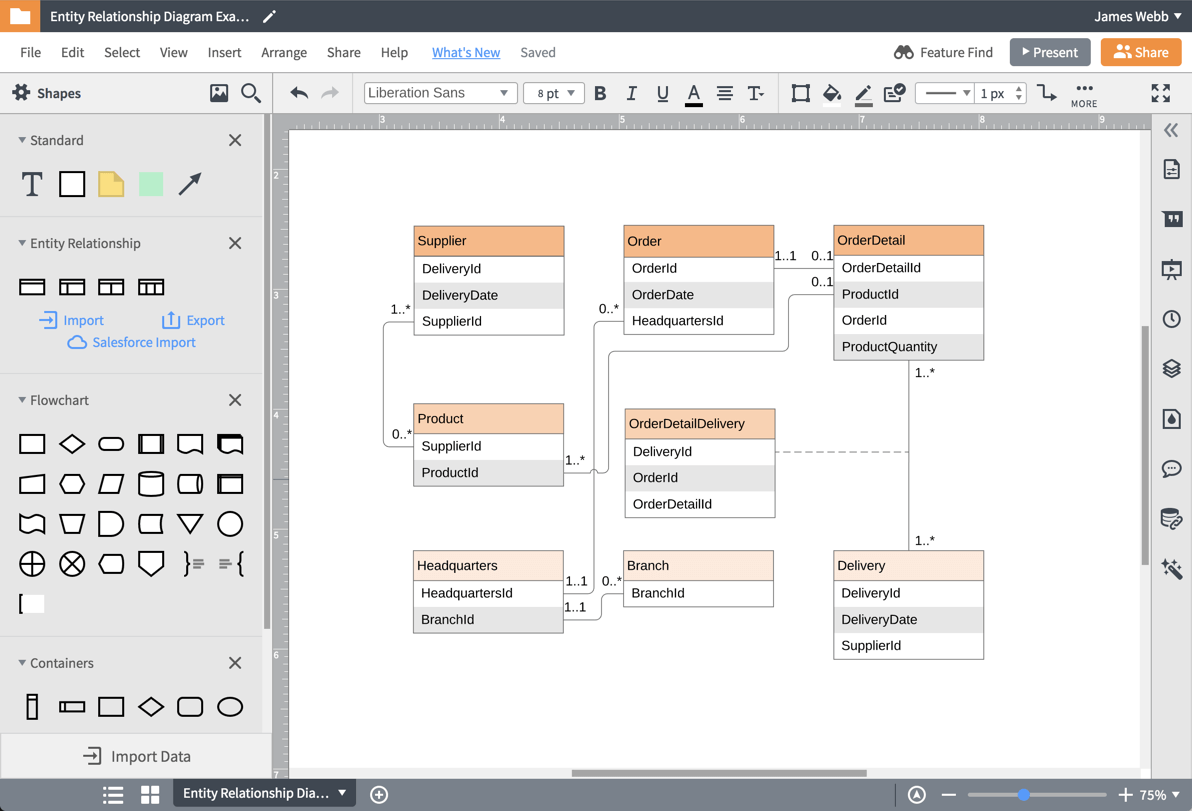How To Create Data Model Diagram
ER diagram tool
Lucidchart is a visual workspace that combines diagramming, data visualization, and collaboration to accelerate understanding and drive innovation.

Your entity relationship diagram tool to simplify database modeling
-

Visualize relationships with our ER diagram maker
Entity relationship diagrams (ERDs) help you understand relationships between entities within a system, such as customers, products, or order IDs. An entity relationship diagram tool like Lucidchart helps you conceptualize your database design before you build it, including the overall structure and the ways different types of data interact, if at all. So, if you're designing, patching, or debugging relational databases, use Lucidchart to create ER diagrams online to easily visualize your schemas, while spotting and correcting flaws early on.
-

Draw ER diagrams using templates, symbols, and notations
Our ER diagram tool simplifies database modeling, whether your ERDs are conceptual or physical. With dedicated shape libraries, drag and drop standard ERD symbols onto the canvas within seconds. Lucidchart is the essential ERD tool to quickly differentiate relationships, entities, and their attributes. Include tables, fields, and primary or foreign keys, then connect each entity with specific crow's foot notations to indicate the cardinality and ordinality of each entity. Generate ER diagrams automatically, draw one from scratch, or customize a template with the right symbols and notations to match your database structure.
-

Import your database structure to streamline ERD creation
Lucidchart makes it easy to visualize your database structure and build ER diagrams online quickly and efficiently to save you time. Our ER diagram creator automatically generates your models and connections using our data import feature to structure your database tables and schemas directly onto the canvas. Worry less about updating your models every time you make a change—Lucidchart updates fields in your ERD whenever you import new or revised database files. You can even export your ER diagram from Lucidchart back into your DBMS of choice, including MySQL, PostgreSQL, SQL Server, or Oracle.
-

Import your Salesforce schema
Unlike other ER diagram tools, Lucidchart eliminates the hassle of managing your Salesforce object infrastructure and lets you visualize hypothetical changes before implementing them in Salesforce. With our Salesforce schema builder, Salesforce admins and consultants can instantly turn objects, relationships, and relevant Salesforce fields into an ERD to discover optimal solutions and improvements custom to their team's needs within Salesforce. Our ER diagram software automatically generates an ERD of your instance—all you have to do is simply import your Salesforce schema in Lucidchart.
-

Collaborate and share with anyone, from anywhere, at anytime
With Lucidchart, you can invite collaborators to help draw out your ER diagrams, communicate plans and ideas, and quickly assess the accuracy of your models. Our ER diagram maker enables teams and stakeholders to work on the same diagram collectively, viewing all changes and updates in real time no matter their device, operating system, or time zone. Our range of sharing options help you manage who can access and edit your diagrams while features like sticky notes, comments, and @mentions let you notify and point individuals to specific areas or shapes in your diagram. You can also share your ER diagrams outside of Lucidchart in several ways. Insert your models into a Jira ticket, a Confluence wiki page, or in any popular app integrated with Lucidchart. Use an ERD tool to create visuals in your docs, spreadsheets, and slide decks to help you facilitate universal understanding among any audience, no matter their levels of technical knowledge.
How to draw ER diagrams online in Lucidchart
1
Enable the entity relationship shape library
Open the shape manager in Lucidchart and select the "Entity Relationship" library, which includes standard ERD symbols and our import/export feature to connect to your DBMS or Salesforce account.
2
Determine the entities from your database
Entities represent a table in your database. Depending on the subject of your diagram, your entity could be a customer, product, or even a physical location, like a bank.
3
Identify the relationships between entities
Relationships highlight how entities will interact with each other, if at all. Within your er digram, indicate entity relationships by drawing lines between them and then adding the appropriate cardinality on each end.
4
Add all necessary entity attributes
Attributes are the specific properties or traits of an entity that are important in your model, such as the first and last name of a customer entity. Add your attributes and the associated primary and foreign keys.
5
Export your ERD to the DBMS of your choice
Lucidchart automatically generates the SQL commands you need to match your ERD to your DBMS. Simply click the export featured link from your entity relationship shapes, select your DBMS, and follow the instructions for copying the generated commands and applying them to your database.
Make an ERD
Frequently asked questions about ERDs
Do you have any ER diagram examples to help me get started?
How can I automatically generate an ERD from my current database system?
How do I create an ER diagram from scratch?
Can I import my current Salesforce schema into Lucidchart without having to create it from scratch?
Can I export my ER diagrams once I'm finished?
Easily create ER diagrams with Lucidchart

Used by millions across the globe
"Mapping out a future database structure or creating a diagram of software architecture is fast and easy. We have used presentation mode frequently in meetings. Lucidchart is really a joy to use."

4.5/5 stars 650+ reviews
Browse ER diagram templates
See why 99% of Fortune 500 companies securely scale their enterprises with Lucidchart
How To Create Data Model Diagram
Source: https://www.lucidchart.com/pages/examples/er-diagram-tool
Posted by: olsongrins1936.blogspot.com

0 Response to "How To Create Data Model Diagram"
Post a Comment